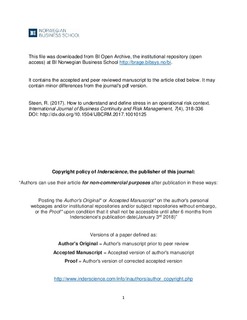How to understand and define stress in an operational risk context
Journal article, Peer reviewed
Accepted version
Permanent lenke
http://hdl.handle.net/11250/2485353Utgivelsesdato
2017Metadata
Vis full innførselSamlinger
- Publikasjoner fra CRIStin - BI [1015]
- Scientific articles [2181]
Originalversjon
International Journal of Business Continuity and Risk Management (IJBCRM). 2017, 7 (4), 318-336. 10.1504/IJBCRM.2017.10010125Sammendrag
This paper aims to provide new insights on the understanding of stress and using this concept in operational risk management. We identify three main lines of definitions of stress: situations having the potential for disruption, the consequences of being exposed to various threats, and the interaction between condition and response to pressures. Based on grounded theory as a methodology and from discussion and linking stress to the concept of uncertainty, this work suggests a new definition of stress as a "two-dimensional combination of threat and coping capability associated with uncertainty". Stress is formalised as (Th, Cc, U), where Th represents the threat (or amount of pressure), Cc represents coping capability, and U represents uncertainty about the magnitude of the threat and existing capabilities of coping with it. The present paper introduces three interrelated strands of operational risk: sense making, decision making, and performance. Using many examples related to operational risk in banking, this study demonstrates how different components of the proposed definition of stress may influence exposure to operational risk in each of its strands.
Beskrivelse
The accepted and peer reviewed manuscript to the article
